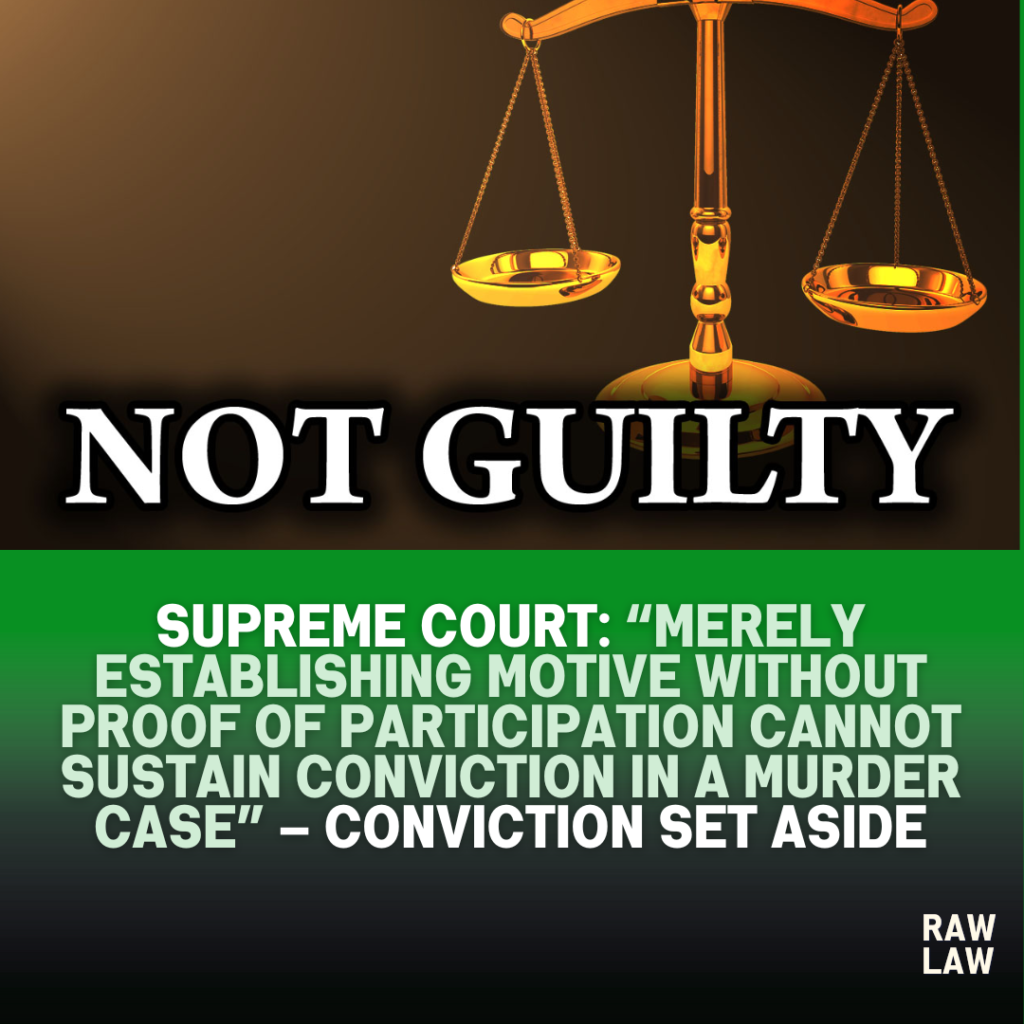Court’s Decision
The Supreme Court set aside the conviction for murder under Section 302 of the Indian Penal Code, holding that the prosecution had failed to establish the participation of the accused beyond reasonable doubt. The Court reiterated that “motive alone cannot establish guilt” and emphasized that the prosecution must prove the actual involvement of the accused in the crime. The Court concluded that when evidence regarding identification and recovery is doubtful, and the chain of circumstances is incomplete, the benefit of doubt must go to the accused.
Facts
The prosecution alleged that the accused, along with others, committed the murder of a person by attacking him with weapons. The motive attributed was prior enmity and disputes between the deceased and the accused. The prosecution case was primarily built on circumstantial evidence, including alleged recovery of weapons, identification by witnesses, and motive of revenge.
The trial court convicted the accused under Section 302 IPC and sentenced them to life imprisonment. The High Court affirmed the conviction, holding that the motive was clear and that the circumstantial evidence sufficed to prove guilt. Aggrieved, the accused approached the Supreme Court.
Issues
- Whether motive alone can form the basis of conviction in the absence of reliable evidence connecting the accused to the actual crime.
- Whether the prosecution established a complete chain of circumstances leading only to the conclusion of the accused’s guilt.
- Whether the recovery of weapons and identification evidence was sufficient to sustain conviction.
Petitioner’s Arguments
The petitioners contended that the conviction was unsustainable as it rested mainly on motive and weak circumstantial evidence. They argued that no eyewitness had conclusively identified them at the scene of crime, and the recoveries made were doubtful and uncorroborated by forensic analysis. They submitted that motive, at best, is a supporting factor and cannot replace direct evidence of participation. They further argued that the chain of circumstances was broken and the benefit of doubt must go to the accused.
Respondent’s Arguments
The State contended that the prosecution had successfully proved the motive, which was strong enough to implicate the accused. It was argued that the recovery of weapons at the instance of the accused and the surrounding circumstances clearly pointed towards their guilt. The State maintained that the cumulative effect of motive, recovery, and conduct of the accused formed a complete chain leading to their conviction.
Analysis of the Law
The Court analyzed the settled principle that in criminal cases, conviction cannot rest solely on motive. Motive, though relevant, is never a substitute for proof of participation. The Court held that the prosecution must establish an unbroken chain of circumstances which unerringly points to the guilt of the accused. Suspicion, however strong, cannot replace proof.
The Court further noted that recoveries must be credible and corroborated with independent evidence. In the present case, doubts existed regarding the authenticity of recoveries and the credibility of identification witnesses. Hence, the standard of proof required for conviction was not met.
Precedent Analysis
The Court relied on several judgments:
- Sharad Birdhichand Sarda v. State of Maharashtra (1984) – The Court reiterated the five golden principles governing circumstantial evidence, which require the chain to be complete and exclude every hypothesis except the guilt of the accused.
- State of U.P. v. Satish (2005) – The Court held that motive alone cannot form the basis of conviction unless corroborated by other reliable evidence.
- Hanumant v. State of Madhya Pradesh (1952) – It was emphasized that suspicion, however grave, cannot take the place of legal proof.
The Court held that these precedents directly applied to the present case, as the prosecution failed to establish the essential link between motive and actual participation.
Court’s Reasoning
The Court reasoned that while the prosecution successfully proved the existence of motive, it failed to link the accused with the actual commission of the crime. The recovery of weapons was not reliable, as there was no forensic evidence to confirm their use in the crime. The identification evidence was shaky, with contradictions in witness testimonies.
The Court stressed that in cases based on circumstantial evidence, every link must be firmly established. Since the prosecution could not rule out alternative possibilities, the accused were entitled to the benefit of doubt.
Conclusion
The Supreme Court allowed the appeal and set aside the conviction and sentence under Section 302 IPC. The accused were acquitted of all charges, with the Court emphasizing that in criminal jurisprudence, suspicion cannot substitute for proof, and motive without participation is insufficient to sustain conviction.
Implications
This judgment reinforces the principle that in criminal cases, motive, though relevant, cannot substitute for concrete evidence. It underscores the strict requirement of a complete chain of circumstances in cases resting on circumstantial evidence. The ruling serves as a reminder that courts must guard against convictions based on speculation, ensuring that only proven participation results in punishment.
FAQs
Q1: Can motive alone be sufficient to convict a person in a murder case?
No. The Supreme Court reiterated that motive alone cannot establish guilt. It must be corroborated by reliable evidence connecting the accused to the actual commission of the crime.
Q2: What is the standard for conviction in cases based on circumstantial evidence?
The Court applied the “five golden principles” from Sharad Birdhichand Sarda, which require that the chain of circumstances must be complete and exclude every hypothesis except the guilt of the accused.
Q3: Why was the conviction set aside in this case?
The conviction was set aside because the prosecution failed to establish a complete chain of circumstances. The recoveries were unreliable, identification evidence was doubtful, and the case rested mainly on motive without proof of participation.



